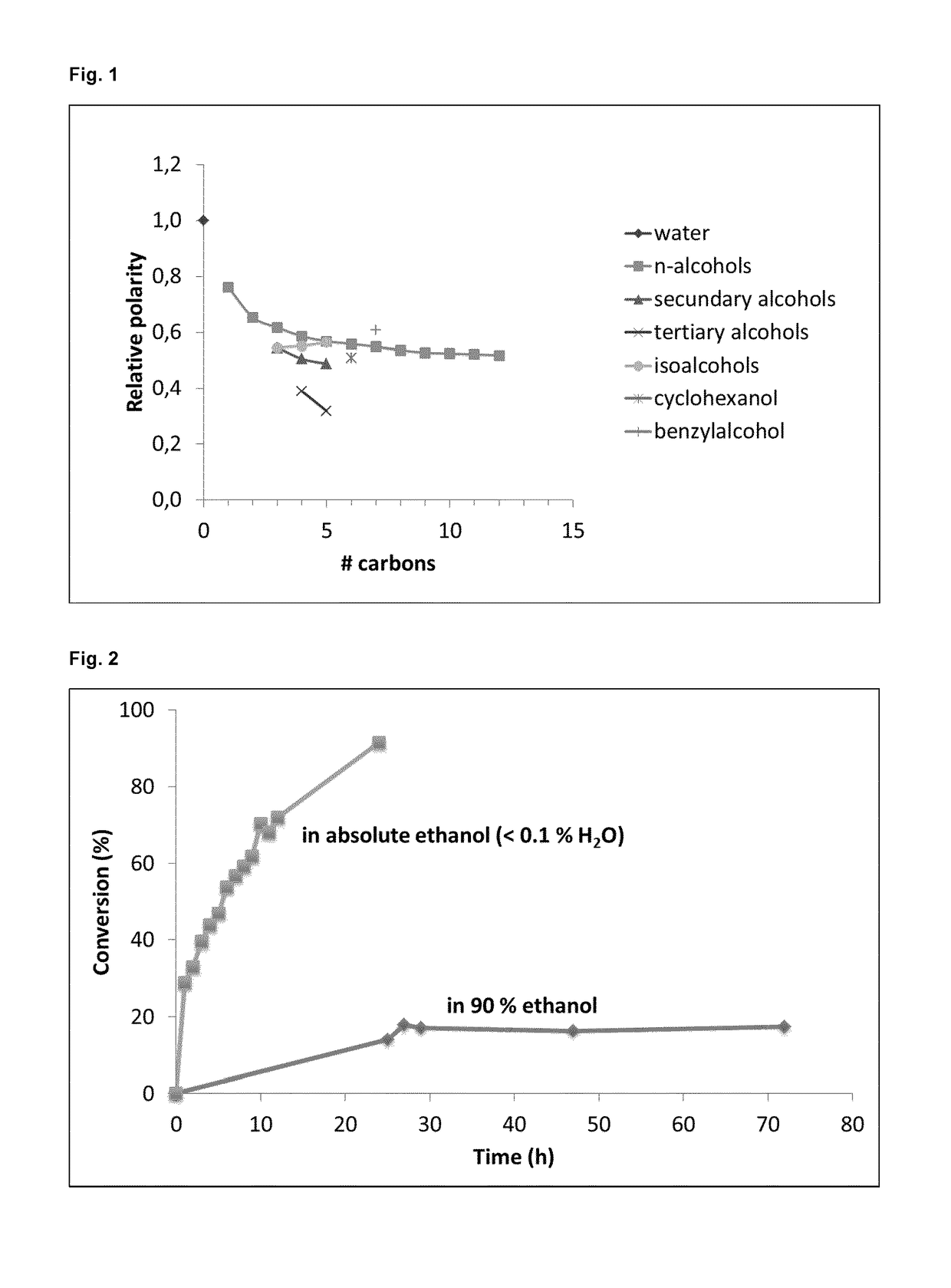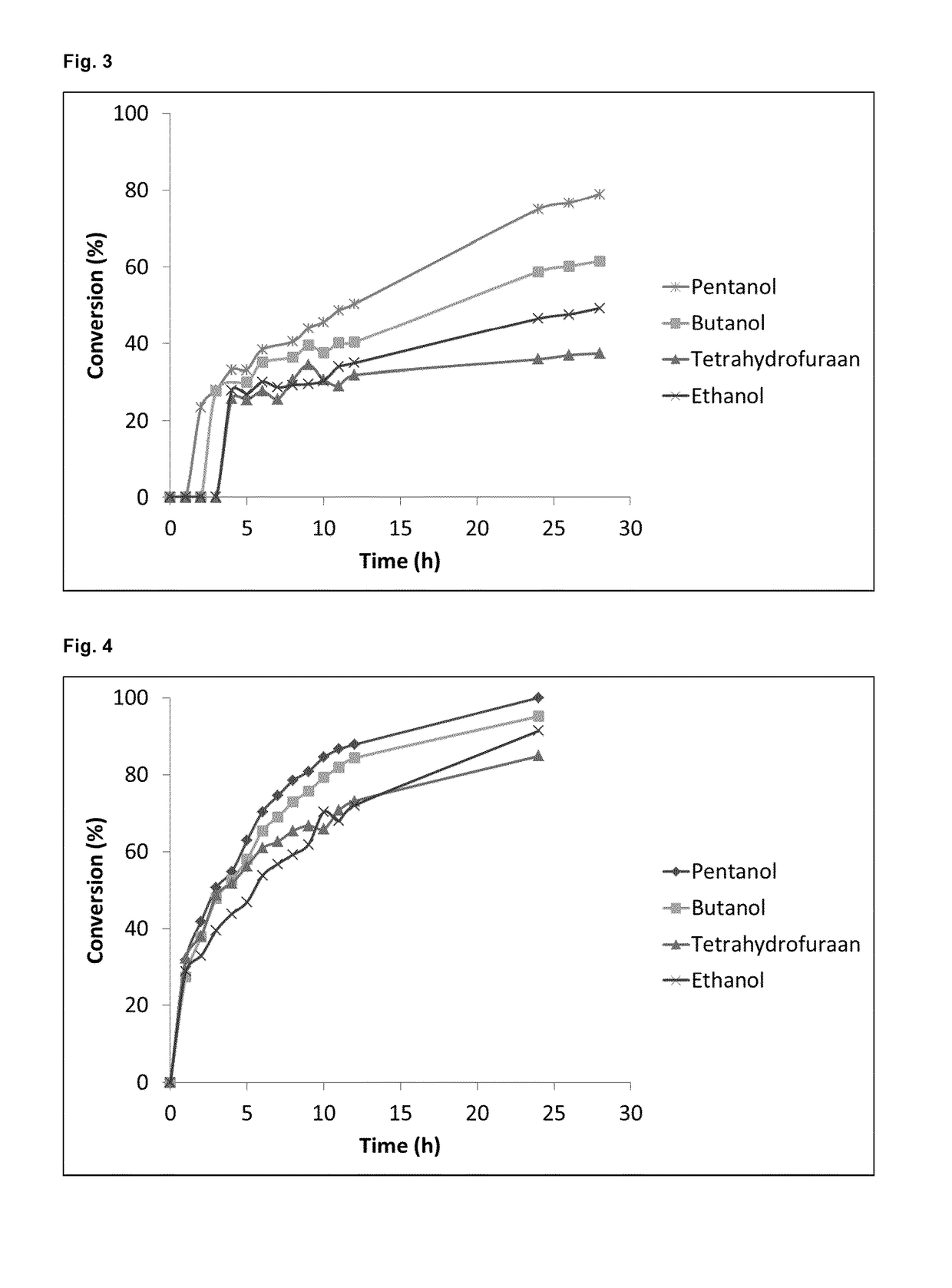Method for the regioselective deacetylation of mannosylerythritol lipids
a technology of mannosylerythritol and enzymolysis, which is applied in the direction of hydrolases, enzymes, enzymology, etc., can solve the problems of compromising product quality and stability, low conversion rate, and low efficiency
- Summary
- Abstract
- Description
- Claims
- Application Information
AI Technical Summary
Benefits of technology
Problems solved by technology
Method used
Image
Examples
example 1
Water from Fukuoka et al.'s (2011) Reaction Solvent Results in a Vast Improvement of the Deacetylation Reaction of Conventional MEL-B Using Novozym® 435
[0069]In a first attempt for the enzymatic deacetylation of the conventional MEL-B, Fukuoka et al.'s method using 90% ethanol as the reaction solvent was replicated. (Fukuoka et al., 2011) However, this resulted in a very low and slow conversion. FIG. 1 shows an 18% conversion after 24 h and no further increase after 72 h. This means that somehow the enzyme was inactivated after 24 h, probably due to the detrimental effect of the solvent, 90% ethanol+10 water, on the enzyme and its carrier. A parallel experiment was carried out where water was omitted from the reaction solvent. Absolute ethanol was used here resulting in a vast improvement of the deacetylation of the conventional MEL-B. After 24 h the conversion reached 91%. (FIG. 2)
[0070]Materials and Methods
[0071]Two 14 g / l MEL-B solutions were prepared, one in 90% ethanol and one ...
example 2
of Different Organic Solvents with Different Polarities (Log P) for the Regiospecific Deacetylation of Purified MEL-A and MEL-B
[0076]Materials and Methods
[0077]THF, toluene, cyclohexane, ethanol, butanol, pentanol, hexanol, heptanol and octanol containing 50 g / l immobilized enzyme (Novozym® 435, ≧5000 PLU / g, Sigma-Aldrich, Belgium) and 14 g / l of conventional MEL-A (4-O-[(4′,6′-di-O-acetyl-2′,3′-di-O-alka-noyl)-β-D-mannopyranosyl]-meso-erythritol) or conventional MEL-B (4-O-[(6′-mono-O-acetyl-2′,3′-di-O-alka-noyl)-β-D-mannopyranosyl]-meso-erythritol), were tested each for their suitability as a solvent for enzymatic deacetylation. The reaction temperature was 60° C. in each case and the shaking speed 200 rpm.
[0078]Results
[0079]In the pure solvent, i.e. without the addition of water, after 24 h the conversion of MEL-A to MEL-C was 76% with octanol, 77% with heptanol, 78% with hexanol, 72% with pentanol, 60 with butanol, 47% with ethanol and 36% with THF (FIG. 3). After 5 days (120 h) ...
example 3
tion of the Fermentation Product Consisting of a Mixture of MEL-A, -B, -C and -D in Butanol
[0082]Materials and Methods
[0083]A first TLC sample was prepared by dissolving 0.25 g of the MEL-mix containing MEL-A, -B, -C and D in 10 ml of ethyl acetate. 5 g of the MEL-mix was dissolved in 100 ml of butanol in a 200 ml erlenmeyer flask with screw cap. 5 g of Novozym® 435 were added. The whole was shaken at 180 movements per minute in an incubator at 60° C.
[0084]After 2 days and 5 hours (53 hours), the reaction was stopped. The solution was filtered through a paper filter on a funnel.
[0085]The filtrate was then filtered through a PTFE filter (0.2 μm) and the collected volume was placed in a vacuum centrifuge at maximum speed (1500 rpm) and 57° C. for 21 hours. A second TLC sample was then prepared by dissolving 0.25 g of the remaining sticky brown syrup into 10 ml of ethyl acetate.
[0086]Results:
[0087]After 53 hours, the substrate has been almost completely converted into MEL-C and -D (TLC...
PUM
 Login to View More
Login to View More Abstract
Description
Claims
Application Information
 Login to View More
Login to View More - R&D
- Intellectual Property
- Life Sciences
- Materials
- Tech Scout
- Unparalleled Data Quality
- Higher Quality Content
- 60% Fewer Hallucinations
Browse by: Latest US Patents, China's latest patents, Technical Efficacy Thesaurus, Application Domain, Technology Topic, Popular Technical Reports.
© 2025 PatSnap. All rights reserved.Legal|Privacy policy|Modern Slavery Act Transparency Statement|Sitemap|About US| Contact US: help@patsnap.com



